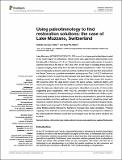Por favor, use este identificador para citar o enlazar a este item:
http://hdl.handle.net/10261/152854COMPARTIR / EXPORTAR:
 SHARE SHARE
 CORE
BASE CORE
BASE
|
|
| Visualizar otros formatos: MARC | Dublin Core | RDF | ORE | MODS | METS | DIDL | DATACITE | |

| Campo DC | Valor | Lengua/Idioma |
|---|---|---|
| dc.contributor.author | Larocque Tobler, Isabelle | - |
| dc.contributor.author | Pla-Rabes, Sergi | - |
| dc.date.accessioned | 2017-07-14T11:08:21Z | - |
| dc.date.available | 2017-07-14T11:08:21Z | - |
| dc.date.issued | 2015-07-01 | - |
| dc.identifier.citation | Front. Ecol. Evol. 3: 70 (2015) | - |
| dc.identifier.issn | 2296-701X | - |
| dc.identifier.uri | http://hdl.handle.net/10261/152854 | - |
| dc.description.abstract | Lake Muzzano (45°59′50″N 8°55′41″E, 337 m a.s.l.) is a hyper-eutrophied lake located in the Tessin region of Switzerland. Almost every year, algal blooms (Microcystis) cover the lake with a thickness of 1–2 cm. These blooms associated with periods of anoxia in summer have led to fish kills in 1967 and 1994. In the hope of avoiding these blooms, a bypass bringing water away from the lake has been established in 1999. This solution was not adequate as blooms kept reoccurring. Sediment removal was then proposed by the Tessin Canton as a possible remediation technique and The L.A.K.E.S Institute had a mandate in 2010 to study the lake (present and past state) to determine the reasons creating anoxia and algal blooms. The present state of the lake shows that anoxia is still occurring when the algal bloom covers the lake's surface. Subfossil diatom and chironomid analyses show that the baseline conditions were those found before 1922 AD when the lake was oligotrophic and supported a diversified community of chironomids suggesting good oxygenation. After 1922 AD, circulation to the lake was cut out and nutrients accumulated in the lake leading to anoxia and the establishment of Microcystis. Heavy metal analysis in the sediment shows that the concentration is above the national recommendation and thus sediment should not be removed or should be stored with hazardous material. Based on the present status of the lake and paleolimnological results, two solutions are proposed: to further decrease the nutrients coming in the lake (possibly using filtrating plants) followed by flushing to increase lake water circulation. Physical capping of the sediment to avoid exchange of heavy metals and phosphorus release at the water/sediment interface could also be envisaged once the two prime solutions are in place. | - |
| dc.publisher | Frontiers Media | - |
| dc.relation.isversionof | Publisher's version | - |
| dc.rights | openAccess | - |
| dc.title | Using paleolimnology to find restoration solutions: the case of Lake Muzzano, Switzerland | - |
| dc.type | artículo | - |
| dc.identifier.doi | 10.3389/fevo.2015.00070 | - |
| dc.description.peerreviewed | Peer reviewed | - |
| dc.relation.publisherversion | http://dx.doi.org/10.3389/fevo.2015.00070 | - |
| dc.date.updated | 2017-07-14T11:08:21Z | - |
| dc.description.version | Peer Reviewed | - |
| dc.language.rfc3066 | en | - |
| dc.rights.holder | Copyright © 2015 Larocque-Tobler and Pla-Rabès. | - |
| dc.rights.license | http://creativecommons.org/licenses/by/4.0/ | - |
| dc.relation.csic | Sí | - |
| dc.type.coar | http://purl.org/coar/resource_type/c_6501 | es_ES |
| item.openairecristype | http://purl.org/coar/resource_type/c_18cf | - |
| item.fulltext | With Fulltext | - |
| item.cerifentitytype | Publications | - |
| item.openairetype | artículo | - |
| item.grantfulltext | open | - |
| Aparece en las colecciones: | (CREAF) Artículos | |
Ficheros en este ítem:
| Fichero | Descripción | Tamaño | Formato | |
|---|---|---|---|---|
| Using paleolimnology to find restoration solutions.pdf | 2,35 MB | Adobe PDF |  Visualizar/Abrir |
CORE Recommender
SCOPUSTM
Citations
5
checked on 27-mar-2024
WEB OF SCIENCETM
Citations
5
checked on 26-feb-2024
Page view(s)
348
checked on 18-abr-2024
Download(s)
223
checked on 18-abr-2024
Google ScholarTM
Check
Altmetric
Altmetric
Este item está licenciado bajo una Licencia Creative Commons

